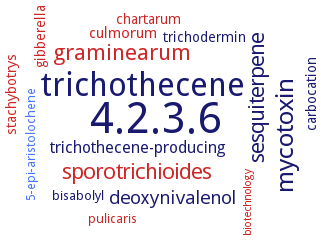4.2.3.6: trichodiene synthase
This is an abbreviated version!
For detailed information about trichodiene synthase, go to the full flat file.

Word Map on EC 4.2.3.6 
-
4.2.3.6
-
trichothecene
-
mycotoxin
-
graminearum
-
sesquiterpene
-
sporotrichioides
-
deoxynivalenol
-
trichothecene-producing
-
culmorum
-
gibberella
-
trichodermin
-
carbocation
-
stachybotrys
-
chartarum
-
pulicaris
-
5-epi-aristolochene
-
bisabolyl
-
biotechnology
- 4.2.3.6
-
trichothecene
-
mycotoxin
- graminearum
-
sesquiterpene
- sporotrichioides
-
deoxynivalenol
-
trichothecene-producing
- culmorum
- gibberella
-
trichodermin
-
carbocation
- stachybotrys
- chartarum
- pulicaris
- 5-epi-aristolochene
-
bisabolyl
- biotechnology
Reaction
Synonyms
EC 4.1.99.6, sesquiterpene cyclase, synthase, trichodiene, TDN synthase, trans,trans-farnesyl-diphosphate sesquiterpenoid-lyase, tri5, trichodiene synthase, trichodiene synthetase
ECTree
Advanced search results
Engineering
Engineering on EC 4.2.3.6 - trichodiene synthase
Please wait a moment until all data is loaded. This message will disappear when all data is loaded.
D100E
D101E
D102E
-
mutation in substrate binding domain, mutant generates anomalous sesquiterpenes
D104E
-
mutant generates anomalous sesquiterpenes, proportion of anomalous products increases if enzyme is incubated in presence of Mn2+
D98E
-
mutation in substrate binding domain, mutant generates anomalous sesquiterpenes
D99E
-
mutation in substrate binding domain, mutant generates anomalous sesquiterpenes
N225D
mutation in the fungal NSE motif, responsible for chelating Mg2+, mutant generates a different distribution of sesquiterpene products
N225D, S229T
mutation in the fungal NSE motif, responsible for chelating Mg2+, inactive mutant
S229T
mutation in the fungal NSE motif, responsible for chelating Mg2+, mutant generates a different distribution of sesquiterpene products
Y295F
mutation in the fungal NSE motif, responsible for chelating Mg2+, mutant generates a different distribution of sesquiterpene products
D109E
-
the mutant with increased activity shows more stability than the wild type enzyme, an increased number of electrostatic interactions and better binding energies with the ligand
D109E/D248Y
-
the mutant with increased activity shows more stability than the wild type enzyme, an increased number of electrostatic interactions and better binding energies with the ligand
D248Y
-
the mutant with increased activity shows more stability than the wild type enzyme, an increased number of electrostatic interactions and better binding energies with the ligand
additional information
D100E
-
mutant generates anomalous sesquiterpenes, proportion of anomalous products increases if enzyme is incubated in presence of Mn2+
-
mutant generates anomalous sesquiterpenes, proportion of anomalous products increases if enzyme is incubated in presence of Mn2+
-
hybrid of enzyme from both organisms, site directed mutagenesis of hybrid
additional information
-
hybrid of enzyme from both organisms, site directed mutagenesis of hybrid


 results (
results ( results (
results ( top
top






